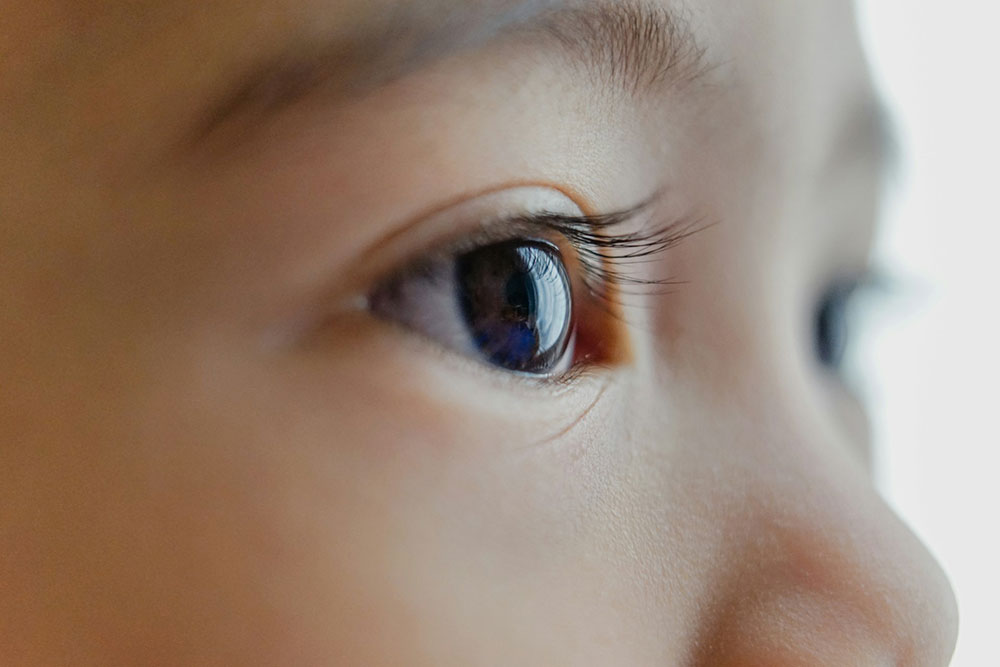An estimated 1.6 million school-age children in the UK have an undiagnosed problem with their vision, according to school census data, courtesy of VisionMatters.org. These problems can include:
- Short-sightedness
- Astigmatism
- Long-sightedness
- Squint
- Amblyopia (lazy eye).
Some of this is just down to bad luck and genetics, but some vision issues relate to poor nutrition and lifestyle choices.
How to support healthy eyesight in children
Other than good nutrition, factors that affect vision health in younger children include:
Play outside!
Outdoor activity has a tonne of benefits for children, including supporting healthy eyesight.
Playing outside can help prevent the onset and progression of short-sightedness in children. This is thought to be partly because we exercise the muscles of the eye in a different way when looking across longer distances outdoors. That’s hard to do when cooped up inside!
Try getting the whole family out for:
- Nature walks
- Bike rides
- Kayaking or wild swimming
- Community clean-ups
- Outdoor art projects
- Photography walks
- Orienteering
- Gardening or yard work.
You can also incorporate outdoor time by having your kids walk or bike to and from school, the shops, or to the homes of friends and family once they’re old enough.
Sun protection
While outdoor activity is vital for vision development, children’s eyes also need more protection from the sun. This is because the lens at the front of the eye is very clear in young children, letting in more damaging rays.
Even on cloudy days, when the UV index is 3 or more, try to have your kid wear sunglasses with robust UV protection. It can be hard to get littler kids to wear sunglasses but once it’s a habit, it becomes much easier. Look for sunglasses with a CE mark, UV 400, or British Standard Mark.
If sunglasses remain a challenge, a wide brim hat is also a good way to protect against UV rays year-round.
Limit screen time
There are many reasons to limit screentime in younger (and older!) children. Healthy vision development is one.
Too much close-up screentime, including on tablets, phones, and laptops, can be damaging to sensitive, developing eyes. If screentime feels unavoidable, consider installing an app that offers reminders to look away from the screen every 20 minutes or so, to allow the eyes to relax and work different muscles.
Get regular vision check-ups
Schools often have visions check-ups for children, which is great for catching eye problems early. If your kid missed ‘eye day’ at school, or you have concerns about their vision, make an appointment with an optician.
Early, regular vision tests can help detect vision problems in children. Often, early detection makes for easier correction, helping to prevent a lifetime of eye problems. Spotting issues like short-sightedness early can also make school more fun for kids and make a huge difference to how they learn. A kid who acts out at school may just be struggling to see the blackboard!
In the UK, children’s eye tests are free through the NHS until the age of 16. For kids who need glasses or contact lenses, vouchers are available to reduce the cost.
Good nutrition for eyesight in children
Along with healthy habits, eating well is essential for healthy vision development in children. This means getting enough of key nutrients including:
Vitamin A
Vitamin A is an important antioxidant that plays a key role in eyesight development. It’s especially important for vision in low light. Vitamin A deficiency is a leading cause of childhood blindness worldwide.
Good sources: Fish and dairy products, and as beta-carotene in carrots, sweet potatoes, and spinach, as well as other fruits and vegetables.
Omega-3 fatty acids
Omega-3, especially docosahexaenoic acid (DHA) is important for the development of the retina in utero and in early childhood. It also helps to maintain eye health and reduce the risk of eye disease later in life.
Good sources: Oily fish, flaxseed, chia seeds, walnuts, and as algal oil.
Lutein and zeaxanthin
Part of the carotenoid family, lutein and zeaxanthin are highly concentrated in the retina, where they offer impressive antioxidant activity. These pigments protect against UV damage and other kinds of oxidative damage, helping to protect sensitive developing eyes.
Good sources: Spinach, kale, corn, broccoli, peppers, other brightly coloured fruits and veggies, and edible flowers!
Zinc
Vital for healthy growth and development in all children, zinc is also important for supporting the function of vitamin A in the eyes. It also helps with healing and immune function.
Good sources: Nuts and seeds, beans and pulses, whole grains, beef, and chicken.
Vitamin C
Vitamin C is another antioxidant that helps support tissue growth and immune function. It is also key to healthy blood vessels in the eyes and is associated with a lower risk of cataracts and macular degeneration in later life.
Good sources: Fruits and veggies, especially citrus fruits and bell peppers.
Vitamin E
Vitamin E is a fat-soluble nutrient, meaning it can help protect parts of the eye that vitamin C (which is water-soluble) cannot. This nutrient works with vitamins A and C, as well as zinc, to quash free radical damage and support healthy cell membranes in delicate eye tissue.
Good sources: Nuts and seeds, avocados, and spinach.
Final thoughts on children’s eye health
If your kid likes to eat their fruits and veggies, getting enough vitamin A and C should be a breeze. Those other nutrients can be a little hard to come by, though, especially if your kid isn’t the most adventurous eater.
This is where children’s nutritional supplements can help. Designed with little kids in mind, these specialty supplements are a convenient way to support vision and brain development in those important early years.
Nordic Naturals and Nature’s Aid Children's DHA liquids are a great choice. Available in both Strawberry and Lemon, they also include omega-3 DHA, as well as its counterpart EPA. Nordic Naturals Childrens DHA also includes Vitamin A & D.
These supplements are designed to help protect little eyes from the blue light of digital devices. And all the fish oil is third-party tested and sustainably sourced, so all you have to worry about is wrestling that iPad away from your kid at dinnertime.
References
Sommerburg, O., & Keunen, J. E. (2019). Nutrients and retinal degenerations: from deficiency to supplementation. In Nutrients and retinal degenerations (pp. 1-25). Springer, Cham.
Johnson, E. J., & Vishwanathan, R. (2013). Johnson EJ, Vishwanathan R (2013) Johnson EJ, Vishwanathan R. Rett B. The role of lutein and zeaxanthin in brain and eye health. Nutr Bull, 38(2), 101-110.
SanGiovanni, J. P., & Chew, E. Y. (2005). The role of omega-3 long-chain polyunsaturated fatty acids in health and disease of the retina. Progress in retinal and eye research, 24(1), 87-138.
Chiu, C. J., Taylor, A., & Taylor, A. (2018). Nutritional antioxidants and age-related cataract and maculopathy. Experimental eye research, 126, 69-74.
Chew, E. Y., Lindblad, A. S., & Clemons, T. (2013). The Age-Related Eye Disease Study 2 (AREDS2): study design and baseline characteristics (AREDS2 report number 1). Ophthalmology, 119(11), 2282-2289.


